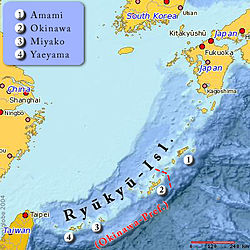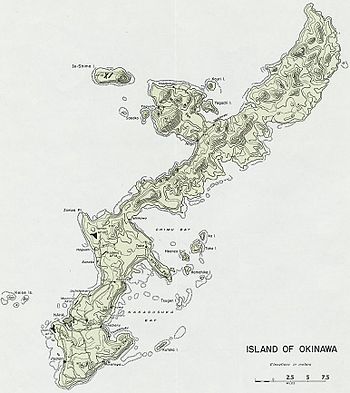- Okinawa Island
-
Okinawa Native name: ジジ (地下) 
Okinawa Island heads up the Ryukyu islands chain, a part of Japan
Geography Location Pacific Ocean Coordinates 26°30′N 127°56′E / 26.5°N 127.933°E Archipelago Ryukyu Islands Area 1,201.03 km2 (463.72 sq mi) Country JapanPrefecture Okinawa Prefecture Largest city Naha (pop. 313,970) Demographics Population 1,384,762 (as of 2009) Density 1,015.79 /km2 (2,630.88 /sq mi) Ethnic groups Ryūkyūans (especially native Okinawans), Japanese people, and expatriates, as well as American military personnel and their families Okinawa Island (沖縄本島 Okinawa-hontō, or 沖縄島 Okinawa-jima) is the largest of the Okinawa Islands and the Ryukyu Islands of Japan, and is home to Naha, the capital of Okinawa Prefecture. The island has an area of 1,201.03 square kilometers (463.72 sq mi). It is roughly 400 miles (640 km) south of the rest of Japan.
Contents
History
The island of Okinawa was the site of most of the ground warfare in the Battle of Okinawa during World War II, when American Army and Marine Corps troops fought a long and bloody battle to capture Okinawa, so it could next be used as the major air force and troop base for the planned invasion of Japan. During this 82-day-long battle, about 100,000 Imperial Japanese Army troops and 12,510 Americans were killed, and in addition to these deaths, somewhere between 42,000 and 150,000 Okinawan civilians - approximately one quarter of the civilian population - were also killed.
During the American military occupation of Japan (1945–52), which followed the Imperial Japanese surrender on September 2, 1945, in Tokyo Bay, the United States controlled Okinawa Island and the nearby Ryukyu islands and islets. These all remained in American military possession until June 17, 1972, with numerous U.S. Army, U.S. Marine Corps, and U.S. Air Force bases there.
Since 1972, United States Armed Forces personnel have remained on Okinawa Island by the invitation of the Government of Japan as a measure partially fulfilling the Treaty of Mutual Cooperation and Security between the United States and Japan.
There has been a strong movement among the local Japanese Okinawan population against the American military and naval presence on Okinawa, especially after several rape cases that were prosecuted against American servicemen. The most widely-known rape took place on September 4, 1995, when three American servicemen, the U.S. Navy seaman Marcus Gill and two U.S. Marines, Rodrico Harp and Kendrick Ledet, all from Camp Hansen on Okinawa, kidnapped and raped a 12-year-old 6th-grade Japanese girl. All three were arrested, tried, convicted, and imprisoned for this crime.
In February 2010 an earthquake, measuring 7.0 on the Richter Scale, hit the island.
Demographics
As of September, 2009, the Japanese government estimates the population at 1,384,762.[1] This total comprises Ryūkyūans (especially native Okinawans), Japanese people, and expatriates, as well as American military personnel and their families. The Okinawan language is called Uchinaguchi, although most residents speak Japanese.
Whereas northern Okinawa Island is largely unpopulated, the south is markedly urbanized—particularly the city of Naha, and the urban corridor stretching north from there to the city of Okinawa. The island also houses six gusuku, Okinawan fortresses most of which now lie in a state of ruin.
Geography and climate
The island has an area of 1,201.03 square kilometers (463.72 sq mi). It is smaller than Oahu. It is roughly 400 miles (640 km) south of the rest of Japan.
The southern end of the island consists of uplifted coral reef, whereas the northern half has proportionally more igneous rock. The easily eroded limestone of the south has many caves, the most famous of which is Gyokusendō in Nanjō. An 850 m stretch is open to tourists.
The island's subtropical climate supports a dense northern forest and a rainy season occurring in late spring.
Transportation
Naha Airport serves the island.
Film
Okinawa was also the setting for the 1986 film The Karate Kid, Part II where Mr Miyagi (Pat Morita) returns home to Okinawa with his student Daniel LaRusso (Ralph Macchio). Although Okinawa was the setting for the film only small scenes of the film were actually filmed in Okinawa ,whereas the majority of the filming was done in Oahu, Hawaii, USA due to Oahu having a similar climate , the island's large Okinawan population as well as the convenience of shooting in the U.S.
See also
- Ryūkyūan history
- Okinawan martial arts
- 1995 Okinawan rape incident
Photo gallery
-
Okinawa Island from Space Shuttle Mission STS-43 (Earth Sciences and Image Analysis, NASA-Johnson Space Center)
-
Bullfighting arena. Okinawa is the home of a form of bullfighting sometimes compared to sumo
References
External links
Categories:- Ryukyu Islands
- Islands of Okinawa Prefecture
- World War II sites
Wikimedia Foundation. 2010.













